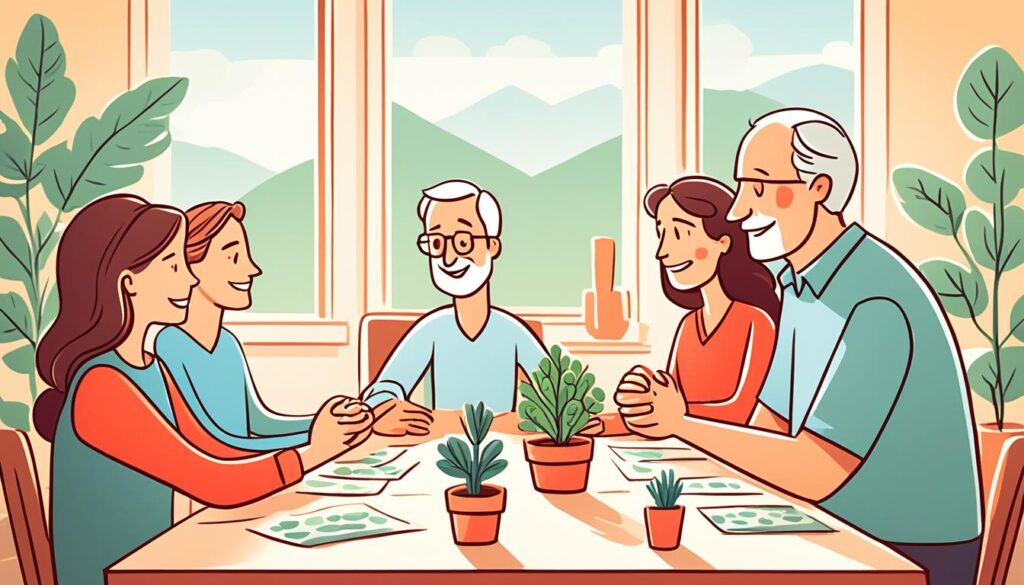Anxiety affects nearly one in five people in the U.S. each year. While some anxiety is normal, too much can really get in the way of daily life. That’s why getting help is key.
Therapies for anxiety help people figure out what makes them anxious and how to deal with it. This article looks at the best ways to tackle anxiety, like cognitive-behavioral therapy and mindfulness.
Finding the right therapy can really help with anxiety. It can make symptoms better and improve how you feel overall. By learning about different treatments, people with anxiety can make better choices and work with professionals to find what works best for them.
Table of Contents
ToggleUnderstanding Anxiety Disorders
Anxiety disorders are common mental health issues marked by too much fear, worry, and nervousness. They can really affect someone’s everyday life and happiness. Knowing about the different types of anxiety disorders and their symptoms is key to finding the right help and support.
Types of Anxiety Disorders
There are many anxiety disorders, like generalized anxiety disorder (GAD), social anxiety disorder, and panic disorder. Other types include specific phobias, obsessive-compulsive disorder (OCD), and post-traumatic stress disorder (PTSD). Each one has its own set of symptoms that need specific treatment.
Symptoms of Anxiety
Anxiety disorders often bring together both mental and physical signs. These signs can include trouble sleeping, unexplained pain, stomach problems, too much worry, feeling not good enough, a fast heartbeat, trouble focusing, and getting easily annoyed. If these signs make it hard to live normally, it might mean you have an anxiety disorder. It’s important to see a licensed mental health expert for help with these issues.
To learn more about anxiety disorders and how to get help, check out [https://drchandrilchugh.com/understanding-autism-spectrum-disorder-and-how-to-get-help-autism-treatment-center-dr-chandril-chugh/].
Cognitive-Behavioral Therapy for Anxiety
Cognitive-behavioral therapy (CBT) is a top choice for managing anxiety. It helps by changing negative thought patterns that cause anxious feelings and actions. By learning to spot and question these thoughts, people can find better ways to cope with anxiety.
CBT for anxiety uses several key techniques to improve mental health:
- Cognitive Restructuring: This method helps clients challenge negative thoughts that make them anxious. They learn to think more realistically.
- Exposure Therapy: This involves facing fears in a safe way. It helps people learn to handle their anxiety better over time.
- Behavioral Activation: CBT encourages doing things that match their values and goals. This helps fight the avoidance that comes with anxiety.
CBT therapists work with clients to create strategies for changing thought patterns and cognitive-behavioral therapy techniques. These strategies are tailored to the client’s needs. This approach is proven to work well for many CBT for anxiety disorders, like generalized anxiety and social anxiety.

CBT helps people take charge of their mental health. It offers a structured way to manage anxiety for the long term and improve life quality. With ongoing research supporting its benefits, it’s a leading choice for those fighting anxiety.
Exposure-Based Therapies
Exposure-based therapies are a key way to handle anxiety disorders. They include methods like graded exposure and systematic desensitization. These methods help people face their fears to reduce anxiety.
Graded Exposure and Systematic Desensitization
Graded exposure slowly introduces people to things they fear, in a safe space. This helps them stop avoiding their fears and get used to them over time. Systematic desensitization adds relaxation techniques like deep breathing to this process.
This makes it easier for people to handle their anxiety as they face their fears. These therapies work well for those with specific phobias and PTSD. By facing fears in a controlled way, people learn to deal with anxiety and take back control of their lives.
The success of these therapies comes from their step-by-step approach. Clients work with therapists to create a plan that starts with small steps. As they progress, they build confidence and skills, reducing their anxiety.
Adding exposure-based therapies to treatment plans helps people with anxiety feel more free. It can help overcome phobias or PTSD symptoms. These methods offer a clear path to lasting relief and personal growth.
Mindfulness-Based Interventions
Mindfulness-based interventions are great for handling anxiety. They include meditation, yoga, and acceptance and commitment therapy (ACT). These practices help us watch our thoughts and feelings without judgment. This leads to better emotional control and flexibility.
Studies show that these therapies can really cut down anxiety. They work best when used with other proven treatments.
Meditation focuses on the now, letting go of past or future worries. It calms the mind and body, easing anxiety symptoms. Yoga adds to this by using breath control and gentle moves. It helps with relaxation and being aware of our body.
ACT is another mindfulness method that boosts flexibility in our minds. It teaches us to accept our thoughts and feelings without fighting them. This makes it easier to handle situations that make us anxious. It’s especially helpful for those with social or general anxiety.

Adding mindfulness to our daily life can change us. It could mean meditating daily, going to yoga classes, or seeing an ACT therapist. These methods give us the skills to handle anxiety better and live happier.
Therapy Interventions For Anxiety
Effective anxiety treatment is more than just therapy sessions. By adding homework and lifestyle changes, we help people manage their anxiety on their own. This approach lets clients use strategies they learn in daily life and track their progress.
Homework and Symptom Monitoring
Therapists give homework to help reinforce what was learned in sessions. This might be practicing relaxation, fighting negative thoughts, or keeping a journal of symptoms. Keeping track of anxiety symptoms and what triggers them helps tailor the treatment plan and see how well the client is doing. Doing these activities at home is crucial to get better at handling anxiety.
Lifestyle Changes: Exercise, Diet, and Sleep Hygiene
Living a healthy life can really help with anxiety. Regular exercise, like running or yoga, can make you feel less anxious by releasing happy chemicals in the brain. Eating well also plays a part in controlling anxiety. Plus, getting enough sleep is key, which means sticking to a bedtime routine.
By using homework and focusing on lifestyle, we help clients take charge of their anxiety. This way, they can use what they learn every day, even outside of therapy. It’s a full approach that prepares people to do well on their own.
Psychoeducation and Support Groups
Dealing with an anxiety disorder can feel overwhelming. But, with the right tools and support, people can learn to handle their symptoms better. Psychoeducation is key in this process. It helps clients and their families understand anxiety disorders, their causes, and how to cope.
Support groups are also crucial. They let people with anxiety disorders connect with others who know what they’re going through. These groups create a sense of community and offer practical advice and emotional support. When family members get involved in treatment, it makes the support system stronger. They learn how to help their loved ones better.
Engaging Family and Loved Ones
Anxiety disorders can really affect a person’s relationships and daily life. Getting family and loved ones involved in treatment helps create a supportive environment. They can learn to spot anxiety signs, support the person, and help with coping strategies. This helps the person feel stronger and better at managing their anxiety.
- Educate family members about the nature of anxiety disorders and effective ways to offer support
- Encourage open communication and collaboration between the client, therapist, and loved ones
- Explore ways for family members to participate in therapy sessions or support group activities
- Provide resources and guidance on creating a home environment that promotes relaxation and stress management
By using psychoeducation, support groups, and family involvement, we can help people with anxiety disorders. They can gain the skills, knowledge, and support they need to improve their mental health and well-being.

Complementary Therapies
Traditional treatments like psychotherapy and medication are common for anxiety disorders. But, some people find help in complementary therapies. Biofeedback and hypnotherapy are two such methods that show promise.
Biofeedback for Anxiety
Biofeedback teaches people to control their body’s responses. This includes heart rate, muscle tension, and skin temperature. It gives real-time feedback on these functions. This helps people manage their anxiety better.
Studies show biofeedback can lower anxiety and boost emotional health.
Hypnotherapy for Anxiety
Hypnotherapy is another therapy that can help with anxiety. It puts you in a deep, focused state. This makes your subconscious mind open to positive ideas.
Hypnotherapy can make you feel calmer and more in control. It also works on the thoughts and beliefs that cause anxiety.
While not a replacement for traditional treatments, biofeedback and hypnotherapy can add to your anxiety management plan. If you’re interested, talk to a healthcare provider to see if they’re right for you.
Pharmacological Treatment Options
Managing anxiety often involves using medication, especially when paired with therapy. Medication alone can’t replace therapy, but it helps ease anxiety and improve daily life.
There are many types of anti-anxiety drugs used to treat anxiety disorders. These include:
- Benzodiazepines, which quickly calm the mind and body by boosting GABA, a neurotransmitter.
- Buspirone, a non-benzodiazepine that works on serotonin receptors in the brain to lessen anxiety.
- Selective serotonin reuptake inhibitors (SSRIs), like fluoxetine and sertraline, which increase serotonin levels to help with anxiety.
- Tricyclic antidepressants, such as imipramine and nortriptyline, effective for anxiety disorders.
- Serotonin-norepinephrine reuptake inhibitors (SNRIs), including venlafaxine and duloxetine, which balance serotonin and norepinephrine in the brain.
Choosing the right medication for anxiety means working closely with a healthcare provider. They will help pick the best types of anti-anxiety drugs for you. By combining therapy and medication, you can find the most effective relief from anxiety.

Choosing the Right Treatment Approach
Managing anxiety disorders requires a customized approach. The best treatment plan depends on the person’s symptoms, diagnosis, and what they prefer. At our practice, we work with our clients to find the right mix of treatments. We look at the type of anxiety, how severe it is, and how well different therapies work.
We team up with our clients to create a detailed treatment plan. This personalized approach is key to making treatments work well and helping our clients get the best results.
When picking the right treatment for anxiety, consider these points:
- Match therapy with the type of anxiety, like generalized, social, or panic disorder.
- Look at how severe the symptoms are and adjust treatments based on that.
- Think about what the client prefers and include their ideas in the plan.
- Keep an eye on how the client is doing and change the plan if needed.
By carefully looking at each client’s situation and working with them, we make sure they get the best anxiety care. This approach helps us tailor treatments to meet their unique needs.
Conclusion
Anxiety disorders are treatable, offering hope to those who feel overwhelmed by worry or fear. There are many ways to help, like cognitive-behavioral therapy and mindfulness. Mental health experts use these tools to help people feel better and live fuller lives.
Working with a therapist helps find the right treatment plan. This way, people with anxiety can find relief and take back control of their mental health. The effective mental health interventions available today give people a chance to overcome anxiety and thrive.
We’re always learning more about anxiety and how to manage it. Our goal is to help people take charge of their mental health. By working together, clients and therapists can create a plan that meets each person’s specific needs and goals.
FAQ
What are the most effective therapy interventions for managing anxiety disorders?
Cognitive-behavioral therapy (CBT), exposure-based treatments, and mindfulness-based techniques are top choices. These methods help people change negative thoughts, face fears, and learn better coping skills.
What are the different types of anxiety disorders?
Anxiety disorders include generalized anxiety disorder (GAD), social anxiety disorder, panic disorder, specific phobias, obsessive-compulsive disorder (OCD), and post-traumatic stress disorder (PTSD). Each has its own set of symptoms like constant worry, fear, panic, and avoiding certain situations.
What are the common symptoms of anxiety disorders?
Symptoms include trouble sleeping, unexplained pain, digestive issues, too much worry, feeling bad about oneself, fast heartbeat, trouble focusing, and getting easily irritated. If these symptoms get in the way of daily life, it might mean you have an anxiety disorder.
How does cognitive-behavioral therapy (CBT) help manage anxiety?
CBT is a top choice for treating anxiety. It helps by changing negative thoughts that lead to anxiety. By learning to question these thoughts, people can handle their anxiety better and find ways to cope.
What are exposure-based therapies and how do they work for anxiety?
Exposure-based therapies are great for specific phobias and PTSD. They work by slowly exposing you to what scares you in a safe way. This helps you get used to it and feel less anxious over time.
How can mindfulness-based interventions help manage anxiety symptoms?
Mindfulness, like meditation and yoga, can really help with anxiety. It teaches you to watch your thoughts and feelings without judgment. This can make it easier to handle your emotions and feel less anxious.
What is the role of homework and symptom monitoring in anxiety treatment?
Homework and tracking symptoms are key parts of treating anxiety. They help you practice new coping skills and keep track of your progress. This makes sure you’re learning and helps your therapist plan better.
How can lifestyle changes impact anxiety symptoms?
Living a healthy life can really help with anxiety. Regular exercise can make you feel more relaxed. Eating well and sleeping well also helps. Encouraging self-care is a big part of treating anxiety.
How does psychoeducation and involving family members benefit anxiety treatment?
Teaching people about anxiety disorders helps everyone understand it better. It makes the experience less scary and helps people get the support they need. Getting family involved can also make things easier for the person with anxiety.
What are some complementary therapies that can be used to manage anxiety?
Besides traditional therapy and medicine, some people find help in other therapies. Biofeedback and hypnotherapy can be useful. They help you control your body’s responses and relax your mind.
When is medication recommended for anxiety disorders?
Sometimes, taking medicine can help with anxiety, along with therapy. Doctors might suggest things like benzodiazepines or antidepressants. But remember, it’s not a replacement for talking therapy and should be used as part of a treatment plan.
How do clinicians determine the most effective treatment approach for an individual with an anxiety disorder?
Finding the right treatment means looking at what symptoms you have, what kind of anxiety you have, and what you prefer. Doctors and therapists work with you to pick the best mix of treatments. This way, you get a plan that really fits your needs.
Source Links
- https://www.icanotes.com/2022/11/29/interventions-for-anxiety/ – Interventions for Anxiety
- https://therapygroupdc.com/therapist-dc-blog/different-types-of-therapy-which-is-best-for-anxiety/ – Different Types of Therapy: Which is Best for Anxiety?
- https://www.helpguide.org/articles/anxiety/therapy-for-anxiety-disorders.htm – Therapy for Anxiety Disorders – HelpGuide.org
About The Author

This article is medically reviewed by Dr. Chandril Chugh, Board-Certified Neurologist, providing expert insights and reliable health information.
Dr. Chandril Chugh is a U.S.-trained neurologist with over a decade of experience. Known for his compassionate care, he specializes in treating neurological conditions such as migraines, epilepsy, and Parkinson’s disease. Dr. Chugh is highly regarded for his patient-centered approach and dedication to providing personalized care.
→ Book a consultation to discover which remedies suit your needs best.




